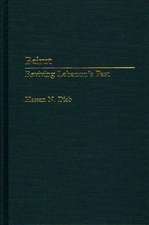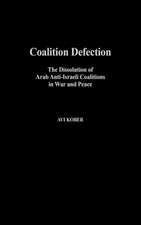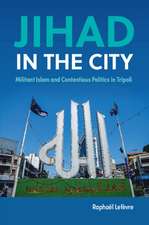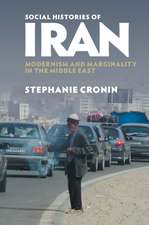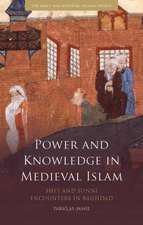Holiest Wars: Islamic Mahdis, Their Jihads, and Osama bin Laden
Autor Timothy R. Furnishen Limba Engleză Hardback – 29 iun 2005 – vârsta până la 17 ani
Preț: 363.89 lei
Preț vechi: 478.99 lei
-24% Nou
Puncte Express: 546
Preț estimativ în valută:
69.63€ • 75.87$ • 58.67£
69.63€ • 75.87$ • 58.67£
Carte tipărită la comandă
Livrare economică 23 aprilie-07 mai
Preluare comenzi: 021 569.72.76
Specificații
ISBN-13: 9780275983833
ISBN-10: 0275983838
Pagini: 192
Dimensiuni: 156 x 235 x 20 mm
Greutate: 0.45 kg
Editura: Bloomsbury Publishing
Colecția Praeger
Locul publicării:New York, United States
ISBN-10: 0275983838
Pagini: 192
Dimensiuni: 156 x 235 x 20 mm
Greutate: 0.45 kg
Editura: Bloomsbury Publishing
Colecția Praeger
Locul publicării:New York, United States
Notă biografică
Timothy R. Furnish teaches world history at Georgia Perimeter College. He learned Arabic while serving in U.S. Army Intelligence and received his doctorate in Islamic History from Ohio State University. His specialty is Islamic eschatology, particularly modern Mahdism-Islamic messianism-and how such beliefs have influenced revolutionary political thought in the Muslim world.
Cuprins
What is Mahdism and Where Does it Come From?Mahdist Movements Throughout HistoryCounter-Mahdist Rationales and PoliciesThe Virtual Mahdi TodayModern Muslim Anti-MahdistsConclusion
Recenzii
This is probably the single most important book in English on this topic.
While cautious about designating any currently visible Islamic fundamentalist as the next Mahdi, Furnish argues that it is only a matter of time before Mahdism reemerges full-blown. And when that happens, all bets will be off and no rules will apply, inside or outside the Islamic community. It is a grim prospect - but one all too credible in the context of Furnish's scholarship.
Throughout the history of Islam, a number of revolutionary movements have emerged that were centered on a rightly guided one who was meant to lead the world to rightness. These movements were based on a branch of Islam known as Mahdism, a topic that Timothy Furnish argues is overlooked in most discussions of the Middle East. Because of the potential of a Mahdist movement to create sweeping changes through violent means, Furnish believes Mahdism to be a particularly applicable subject to the modern context of the Middle East. Furnish addresses the origins of Mahdism, Mahdism throughout history, as well as the potential for a Mahdist movement in modern times.
[P]rovides a perspective on Mahdism, a belief in a messianic figure in Islamic tradition who will unite all Muslims, and debates within the Muslim world on whether bin Laden is that figure.
Jews, Christians and Muslims will all profit from this book because it describes a tradition deeply rooted in all three religions and surprisingly relevant to the current geopolitical situation..[F]urnish writes about Mahdism, the Islamic tradition that anticipates the appearance of a messianic figure who will purify and unite Islam, eradicate all socioeconomic injustices in the world and establish the Muslim faith as a universal religion. This idea is rooted in Judaism, is similar to Christian eschatological ideas and is hotly debated throughout the Muslim world..Most fascinating (and fearful) are his musings about Osama bin Laden's Mahdist potential, especially considering this sobering assertion: Muslim messianic movements are to fundamentalist uprisings what nuclear weapons are to conventional ones: triggered by the same detonating agents, but far more powerful in scope and effect.
While cautious about designating any currently visible Islamic fundamentalist as the next Mahdi, Furnish argues that it is only a matter of time before Mahdism reemerges full-blown. And when that happens, all bets will be off and no rules will apply, inside or outside the Islamic community. It is a grim prospect - but one all too credible in the context of Furnish's scholarship.
Throughout the history of Islam, a number of revolutionary movements have emerged that were centered on a rightly guided one who was meant to lead the world to rightness. These movements were based on a branch of Islam known as Mahdism, a topic that Timothy Furnish argues is overlooked in most discussions of the Middle East. Because of the potential of a Mahdist movement to create sweeping changes through violent means, Furnish believes Mahdism to be a particularly applicable subject to the modern context of the Middle East. Furnish addresses the origins of Mahdism, Mahdism throughout history, as well as the potential for a Mahdist movement in modern times.
[P]rovides a perspective on Mahdism, a belief in a messianic figure in Islamic tradition who will unite all Muslims, and debates within the Muslim world on whether bin Laden is that figure.
Jews, Christians and Muslims will all profit from this book because it describes a tradition deeply rooted in all three religions and surprisingly relevant to the current geopolitical situation..[F]urnish writes about Mahdism, the Islamic tradition that anticipates the appearance of a messianic figure who will purify and unite Islam, eradicate all socioeconomic injustices in the world and establish the Muslim faith as a universal religion. This idea is rooted in Judaism, is similar to Christian eschatological ideas and is hotly debated throughout the Muslim world..Most fascinating (and fearful) are his musings about Osama bin Laden's Mahdist potential, especially considering this sobering assertion: Muslim messianic movements are to fundamentalist uprisings what nuclear weapons are to conventional ones: triggered by the same detonating agents, but far more powerful in scope and effect.





